BLACKCAPS AND PRUNING
/10 Comments/in Flowers, Fruit, Pruning/by Lee ReichBlackcaps All Season (Almost)
It’s a bumper year for blackcaps (also know as black raspberries or, botanically, Rubus occidentalis), at least here on the farmden. Up to last year, we harvested wild blackcaps from plants that pop up at the edges of woods. The current bountiful harvest is from blackcaps that I planted a couple of years ago. Last year’s harvest was unimpressive because the plants were still settling into their new home.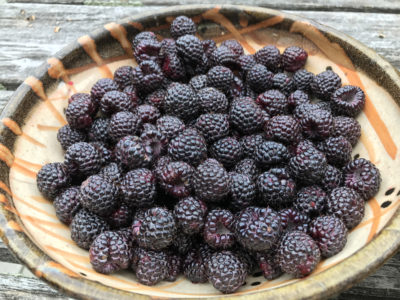
Most blackcaps, like many other bramble fruits, have biennial canes that grow stems and leaves their first year, fruit in early summer of their second year, then die back to the ground. (Annual harvests are possible because while those second year canes are fruiting and then dying, the perennial roots are pushing up new canes, which will bear the following year.)
Niwot and Ohio’s Treasure, the two varieties I planted, stand out from the crowd in bearing on new, growing canes as well as on two-year-old canes. Their two-year-old canes, like those of run-of-the-mill blackcaps, bear now, in early summer. Berries are borne on new, growing canes towards the end of the growing season, until stopped by cold. The next season’s summer crop is borne lower down on those same canes. The upshot of all this is that I get to eat fresh blackcaps in early summer and then again in late summer.
I knew I could expect two crops each season from these varieties when I planted them. That’s why I planted them. What I didn’t know is how abundant and flavorful the berries would be. Unfortunately, for the purposes of evaluation, the two varieties are growing in separate locations that differ markedly from each other. The one in the better location — a humus-rich soil basking in abundant sunlight — yields oodles of large berries. The other variety — planted in a weedy bed shaded from the east by a greenhouse wall — yields less and smaller berries, with perhaps a tad better flavor.
Pruning Recipes
Pruning Niwot and Ohio’s Treasure is as important for ease of picking and pest control as it is for other brambles. And it’s easy.
Right after the current crop grinds to a halt, I’ll cut every cane that bore fruit right to the ground. These two-year-old canes are going to be starting to die anyway. I could cut them down in winter, but cutting them sooner gets the thorny canes out of the way of late summer harvest.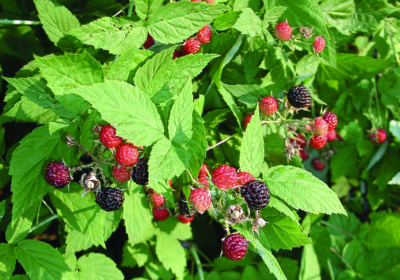
All summer long, I’ll also pinch out the growing tip of any new canes when they reach about four feet in height. Pinching induces side shoots, on which fruits are borne.
That’s it for summer pruning. Sometime next winter I’ll reduce each clump of canes to the six healthiest and shorten each side shoot on remaining canes to about 18 inches long.
All in all, Niwot and Ohio’s Treasure yield a lot of delicious fruit over a long period of time for minimal effort. Now, if only the canes were thornless.
And More Pruning
Whoa, I can’t yet put away the pruning shears. I need the shears for some rose bushes. With the rose “crop” subsided, pruning will get varieties that bear only in June ready for next season, and those that bear again and again through summer to bear again and again.
For roses that bear only once each season, such as the heavenly scented Rose D’Ipsahan, or the cheery, lemon-colored blossoming Father Hugo’s Rose, I cut back some very old stems right to or near ground level, and shorten the remaining stems, some by a quarter of their length, others by three quarters of their length. Then I go over the bush to thin out any crowded stems. This pruning makes room for and stimulates growth of new shoots with ample time for them to initiate flower buds this summer that will unfold next spring.
Repeat blooming roses get pruned differently. The goal is to cut off stems with spent flowers and coax new growth that will flower this season. Instructions for pruning hybrid tea roses are very specific; and I quote: “. . . . cut the stem back to a five-leaflet leaf. Retain at least two five-leaflet leaves on each shoot.”
I don’t grow hybrid teas, which generally are finicky roses, preferring tougher roses such as some of the David Austin varieties, such as L. D. Braithewaite
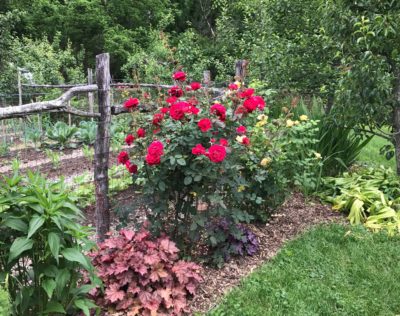
Braithewaite rose
and Charlotte. Pruning is very simple. I just lop stems or groups of stems laden with spent blossoms as far back as I feel like to keep the shrubs from growing too large. They both get another pruning in late winter.
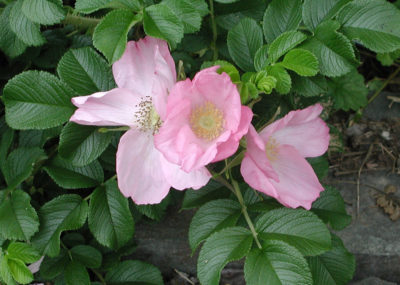 Another rose I grow, rugosa rose, won’t get any pruning this summer. Besides its nonstop, fragrant flowers, rugosa rose also bears nice hips, that is, fruits. The hips make excellent jam and are rich in vitamin C. Pruning in summer would remove spent flowers which then couldn’t go on to swell into fat hips.
Another rose I grow, rugosa rose, won’t get any pruning this summer. Besides its nonstop, fragrant flowers, rugosa rose also bears nice hips, that is, fruits. The hips make excellent jam and are rich in vitamin C. Pruning in summer would remove spent flowers which then couldn’t go on to swell into fat hips.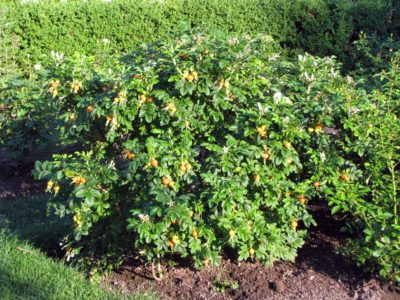
OUT WITH THE OLD, IN WITH THE NEW
/4 Comments/in Fruit, Gardening/by Lee ReichIn Which I Emulate George Washington
It’s about 10 years since I planted the cherry tree, a sweet, self-pollinating variety called Stella, on dwarfing rootstock. During that time, the trunk swelled to about 7 inches in diameter and the branches shot skyward to 20 feet.
Stella is now gone, and it was all my doing. She took ten years to grow but only about an hour to cut down (with my new Stihl cordless electric chain saw, which I highly recommend). Afterlife of her trunk is as firewood, her branches as chipped mulch.
I warned Stella, who never bore one cherry, that this was her last chance. Finally, this spring she was loaded with blossoms, for the first time, followed by a good crop of developing cherries. A couple of weeks later, all the cherries were gone, except for two green ones I noticed on a cut branch. The weather could not have been at fault, nor birds at this early stage in the game. My guess is either an insect, probably plum curculio, or that the tree from the nursery was mislabeled, and it wasn’t Stella. Most varieties of sweet cherry need another variety nearby to set fruit.
She was pretty, but not pretty enough to grow as a strictly ornamental plant.
Oranges, Outdoors, In New York!
Waiting to replace Stella was a citrus(!) tree, a tree I could not have planted even a couple or years ago.
One reason I couldn’t have planted this tree is because it wasn’t a citrus tree back then. It’s a plant called hardy orange, previously assigned the genus and species Poncirus trifoliata. It’s always been a close relative of citrus, even used as a rootstock on which to graft commercial citrus trees. Only recently has it been fully welcomed into the fold and re-assigned the botanical name Citrus trifoliate. So previously I would have been planting a Poncirus but now I planted a Citrus. Same plant, different name.
The other reason I couldn’t have — or shouldn’t have — planted hardy orange under any name previously is because it’s only just barely winter hardy here. Winters of a few years ago were consistently colder and would have killed the plant down to the ground.
With stems cut back from cold, the plant would never have borne flowers, which have the look and delicious fragrance of other citrus flowers, or fruits, which look just like golfball-sized oranges. The flavor of the fruit is nothing to rave about, citrus-y yes, but also very sour, bitter, and not very juicy. Used with restraint, though, the fruits can be used for home-grown citrus flavoring.
The stems themselves, and their ominous thorns are hardy orange’s selling points here. The plant is evergreen, not because it holds onto its leaves through winter but because the stems are bright green year ‘round. My hardy orange is the variety Flying Dragon, whose twisting and turning stems are lined with ominously large, recurved — and also green — thorns.
Flying Dragon is a very interestingly attractive plant that can be used as flavoring, which is more that could have been said for my Stella.
Gumi Good
Except for Stella cherries, this year is shaping up to be an excellent year for fruits, even apples, plums, and other tree fruits, which are always chancy on my farmden, which is a naturally poor site for fruit growing.
Among many other fruits in the offing is a bumper crop of bright red, gold-flecked gumi fruits (Eleaegnus multiflora). The fruits followed sweet-smelling blossoms that perfumed the air earlier in the season and are an ornamental adjunct to the silvery leaves. Plus, the fruits have good flavor if picked thoroughly ripe.
The birds are having a field day with the gumis, so I only get to eat the fruits in their puckery stage when just that hint of good flavor can be detected in the background.
I’ve hung old CD’s among gumi’s branches, also among my mulberries’ branches, hoping the flashes of reflected light will scare birds away. It probably won’t because visual deterrents, when they are effective, are so mostly against flocking birds. The gumis are being enjoyed mostly by robins and catbirds.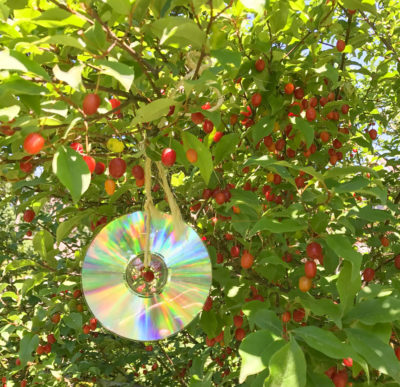
Let the birds have their fun. Black currants, which birds ignore, are also now ripe. And blueberries — my favorite — are ripening, and safe from birds enclosed in the netted “blueberry temple.”
THE GOOD OL’ DAYS
/1 Comment/in Fruit, Gardening, Pests, Planning, Vegetables/by Lee ReichCorn Made Even easier
I can understand why corn was so popular a crop early on in the settlement of our country by Europeans. Sure, it tastes good popped, ground and cooked, and, while immature, fresh from the cob. Mostly, though, corn was easy to grow in the rough soil left from recently cleared forest.
Most of my corn grows in my two vegetable gardens where the soil is crumbly and weed-free, watered gently by drip irrigation, and nourished annually with an inch depth of compost.

Highly cultivated sweet corn
The south garden is home, every year, to a couple of beds (about 60 square feet) of popcorn, and the north garden to 4 beds (about 215 square feet) of sweet corn. Those two gardens provide us with all the sweet corn and popcorn we eat for a year.
Separate gardens are needed because if sweet and popcorn cross-pollinate, the sweet corn will be less sweet and the popcorn won’t pop as well.
I also grow polenta corn, an heirloom Italian variety called Otto File. But I only have two vegetable gardens. So this corn goes out in the field into the weedy soil between my dwarf apple trees. Conditions there aren’t as rough as cornfields wrought from forests in colonial times, but out there the corn must deal with weeds, grasses, rabbits, and drink only water that falls from the sky.
I did not use colonial methods to ready the soil for planting. Instead, I mowed all vegetation to the ground, and covered the planting areas, 2 beds each about 3 feet wide for a total of about 100 square feet of planting, with gray resin paper. (Sometimes called building paper, gray resin paper is used in construction, usually as underlayment under flooring and siding.) I topped the paper with an inch or so of compost, then made two rows in each bed, in each row poking holes 2 feet apart into each of which I dropped 6 Otto File seeds followed by a sprinkling of water.
The seedlings are up and looking strong, so I thinned them out to 3 or 4 plants per hole, pulling out a few weeds as I thinned. I’ll weed one or two more times and then leave the plants to themselves. Weeds will grow, but the then-tall corn plants should shade some into submission and hold their own against the more aggressive ones.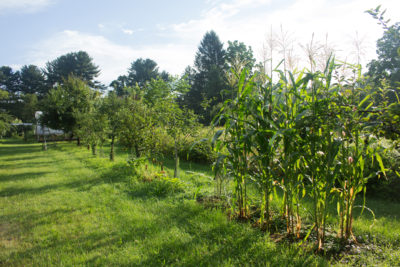
For authenticity, yes, I could have buried some fish in the ground at each planting hole. But that would be more work, and I’m interested in production with minimal effort from that planting. Each year those beds have provided a year’s supply of polenta corn.
Apple Threats
Apple trees flanking the Otto File beds are loaded with a hopeful crop of cherry-sized fruits. The dreaded plum curculio, which is as happy to ruin a crop of apples, peaches, nectarines, or cherries as well as plums, should have ceased their egg-laying by now, and burrowed into the soil to prepare for next year’s onslaught. (Surround® is an organically approved spray of specially formulated kaolin clay that controls curculios.)
Just because the nascent fruits have come along this far does not mean I’m home free. Apple maggot reliably makes its appearance just as the curculios vanish. This pest doesn’t usually make the fruit drop, as do curculios, but it riddles the fruit with so many tunnels that you can’t even eat around them.
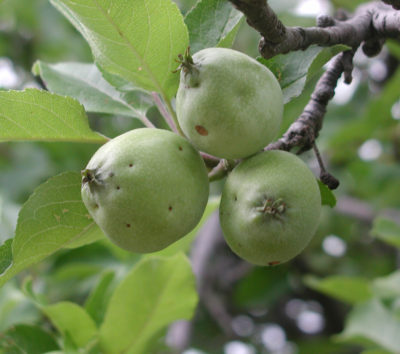
Maggot & curculio scars
Fortunately, non-chemical control of apple maggot is easy. In the 1980s, Dr. Ron Prokopy, at the University of Massachusetts, discovered that Ms. Maggot was attracted to the reddest apples, so he tried hanging croquet balls painted Tartarian Red and coated with forever-sticky Tangletrap® in apple trees. Maggots tried to lay eggs in the ersartz apples, where they expired, their mission unfulfilled. The spheres offer as good control as do chemical sprays.
In the last few years, I’ve used Tangletrap® coated, real Red Delicious apples as traps. They are very red and very apple-like. Hung in the branches, one per dwarf apple tree, they last almost the whole season and, when the season ends, can be composted rather than scraped clean for use the following year.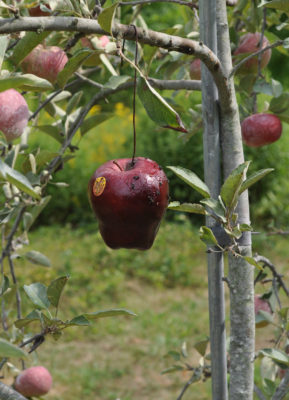
Apple maggot isn’t the only remaining threat to my apples. There’s also the codling moth (the classic worm in the apple), apple scab (that’s what it looks like), and various summer rots.
Once Upon A Time
Oh, for the good ol’ days when the grass was greener, the corn was sweeter, and apple trees took care of themselves. Mostly, the good ol’ days weren’t the various “-ers.” But one exception was the apple maggot. Two hundred years ago, Ms. Maggots didn’t look twice at apples. This native insect was happy to attack our native hawthorns, which are related to apples.
When apples were introduced to this part of the world, some apple maggot flies tried them out. Over time, some began to favor apples over hawthorns, so much so that the maggots evolved into two tribes, one favoring hawthorn and the other apples. Oh well.

